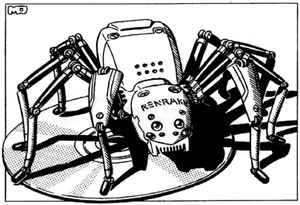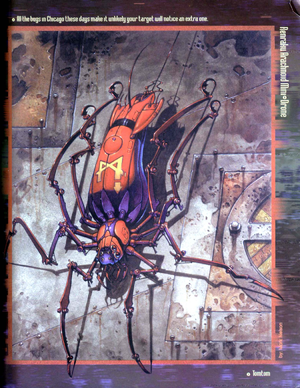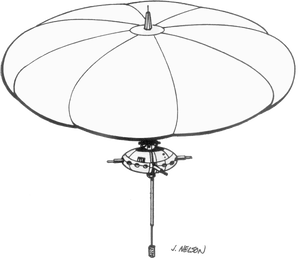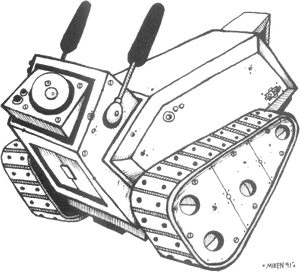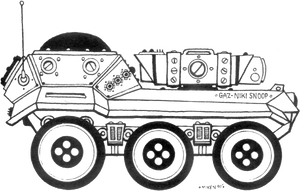Drones
Spider Drones
While the Renraku Arachnoid Mini-Drone is the best-known model of this type, multiple manufacturers produce these diminutive eight-legged drones, ranging in size from fifteen to twenty centimeters. Adept at accessing confined areas, they've been adopted for use in fields ranging from maintenance to security to disaster recovery.
While spider-drones may be piloted using a handheld control system, they are significantly more capable when piloted by a rigger given the complexity of managing eight limbs with hand controls. Non-rigged users have to make checks for basic tasks a rigger wouldn't have to and take Disadvantage to most tasks worth rolling for a rigger.
Basic Spider Drone 12,000¥
- The basic model drone, not capable of being upgraded or augmented in any way.
- The spider drone moves at a modest walking pace and is reasonably adept at surmounting small obstacles.
- Spider drones come with an integrated camera and microphone and are equipped with a small speaker.
- The drone comes with a battery allowing thirty minutes of active maneuvering. The drone drains its battery at one-tenth the normal rate when motionless. Wired drones cannot practically pull a power cable.
- Comes in both wired and wireless versions. While the wireless version allows for more free roaming, it is susceptible to connection issues when the drone is behind multiple layers of concrete, metal, or other signal obstructions. In addition, connectivity to wireless drones may be interfered with through electronic warfare. As such, the wired version, which uses a 100m spool of fiber-optic cable the thickness of fishing line to communicate, is popular for deployment in environments where signal interference is a concern. The drone can rewind the spool when withdrawing from a location.
Rigged Basic Spider Drone 17,000¥
- The basic model drone, not capable of being upgraded or augmented in any way, but adapted for use by a rigger.
- Comes in both wired and wireless versions.
Augmentable Spider Drone 20,000¥
- While the initial configuration of an augmentable spider drone is no more capable than that of a basic spider drone, its ability to accept augmentations to improve its abilities makes it a favorite of high-end security contractors. The augmentations below may only be applied to an augmentable spider drone and not a basic spider drone. Spider-drone augmentations may be swapped out in the field in 10-15 minutes given an appropriately-stocked toolbox and a decently-sized work surface.
- Comes configured for rigger operation.
- Comes in both wired and wireless versions.
Communications Augmentations
One of these augmentations comes with the spider drone when purchased. Only one may be installed at a time.
Fiber-Optic Module 500¥
- Converts a wireless spider drone to a wired spider drone.
Wireless Module 500¥
- Converts a wired spider drone to a wireless connection.
Drive Augmentations
These augmentations apply to the motors powering the drone's movement. Only one drive augmentation may be installed at a time.
Enhanced Speed 7,000¥
- The drone can jog as fast as a reasonably-fit human.
High-Density Battery 4,000¥
- The drone's battery life is tripled.
Quiet Motion 6,000¥
- With a sound-damped motor, silent mechanics, and padded drive pads, the drone moves almost without making a noise.
Drive Legs Augmentations
These augmentations affect the rear-six legs responsible for providing mobility to the drone. Only one drive legs augmentation may be installed at a time.
Jumping 8,000¥
- The drone can jump up to five feet horizontally or vertically from a stand still.
- When used with the enhanced speed drive augmentation the drone can jump up to twenty feet horizontally with a running start. Drones without enhanced speed do not benefit from a walking start.
Wall-Climbing 11,000¥
- With a combination of climbing hooks, electromagnetic grapples, and nano-adhesive surfaces, the drone maneuvers on most walls as if the floor. It can attempt to maneuver on the ceiling or slick surfaces, but this requires skilled piloting and is more likely to be subject to Disadvantage on complex maneuvers.
Vision Augmentations
Only one vision augmentation may be installed at a time.
Low-Light Vision 1,500¥
- The drone has low-light vision.
- Ignore Disadvantage for low-light, but not pitch-black, conditions.
Thermographic Vision 3,000¥
- The drone can switch to a thermographic vision mode allowing the perception of heat signatures.
Enhanced Vision 5,500¥
- Includes both low-light and thermographic vision modes.
Microscopic Vision 1,500¥
- The drone can act as a remote microscope.
- Also allows basic optical vision.
Ultravision 9,000¥
- The drone uses ultrasonic vision instead of optical vision. The ultravision works in a 90° 10m cone in front of the drone.
Jaws Augmentations
The default mouthpiece for the spider drone is cosmetic only. Only one jaws augmentation may be installed at a time.
Computer Multi-Standard Connector 400¥
- A reconfigurable connector compatible with USB, dataport, Lightning, and most other modern computer interfaces.
Mini Cutting Torch 6,000¥
- Capable of cutting through thin metal, melting plastic, or setting wood on fire. While not capable of cutting through the thickness of, say, a steel pipe, this augmentation is popular with those who might send their spider drones scuttling through air vents.
Taser 5,000¥
- This one-use taser fires a pair of barbed projectiles up to fifteen feet, incapacitating any of the target's muscles that lie on the path between the projectiles for as long as current is maintained. A fully-charged spider-drone can maintain this incapacitation for up to a minute at the cost of draining the drone's battery. The projectiles will generally not pierce body armor.
Injector 4,600¥
- A double-barrel injector, one for each fang. May be used individually or simultaneously for larger targets. May be loaded with any injectable substance.
Foreleg Augmentations
These augmentations affect the two front legs used by the drone for manipulation. By default, these legs have high-friction pads on the bottom that may be used to press buttons or perform other basic actions. Each of the two forelegs may be given a different augmentation.
Basic Foreleg 1,200¥
- A spare or replacement basic foreleg w/ high-friction pad.
Tri-Digit Manipulator Hand 7,500¥
- Capable of grasping and manipulating small objects.
- Many manipulation tasks will be at a Disadvantage if done with one hand.
Computer Multi-Standard Connector 500¥
- A reconfigurable connector compatible with USB, dataport, Lightning, and most other modern computer interfaces. Weaker and less agile than the standard foreleg.
Electrical Bypass Tools 5,500¥
- An electrical probe and circuit manipulator capable of being used to finagle a circuit the drone has access to, such as the internals of an electronic lock, if that's the sort of thing the operator knows how to do.
Mechanical Access Tools 9,000¥
- A mini-screwdriver, drill, and pry capable of performing low-strength mechanics actions. Could be used to access the internals of many electronic locks, for example.
Lockpicking Tools 7,000¥
- Comprises an adjustable lockpick and tension tool. Can be used to pick locks if that's something the operator is competent to perform.
Tremorsense 6,000¥
- The drone gains tremorsense for their general vicinity (depending on the local material and the amount of traffic) so long as this foreleg is in contact with the ground. The drone must be motionless for this to be used.
Body Augmentations
These augmentations slot into the main body of the drone. Only one body augmentation may be installed at a time.
Drop Line 6,500¥
- Plants a sticky anchor on a surface, allowing the drone to drop from a ledge, the ceiling, or other point. 15m length. The drone may detach itself from the drop line, but is not strong enough to detach the anchor from the surface.
- Eight uses per deployment.
Extended Fibre-Optic Cable Spool 1,000¥
- Provides a 500m fibre-optic control cable. Can be used as a redundant line for a wired drone or as a backup control system for a wireless drone.
Gas Canister Dispenser 5,000¥
- Can release the contents of one gas canister. Smoke, tear gas, and nerve agents are all popular choices.
Laser Projector System 1,000¥
- Projects a low-resolution monitor-sized display on a nearby surface.
Sticky Device Planter 2,500¥
- A holster for a plantable sticky device. Many small devices can be adapted to this holster given adequate prep time. Mini-grenades, small camera units, wireless repeater modules, and tracking devices are just a few of the types of items adapted for spider-drones. The drone can only carry one device at a time. While it is strong enough to retrieve a planted device, the device will generally only be able to be planted on a vertical or inverted surface once due to degradation of its adhesive surface from application and extraction.
Preconfigured Augmentable Drones
The following augmentable spider-drones come preconfigured with a particular set of augmentations. The augmentations can be swapped out as normal after purchase.
Renraku Tsuchigumo Maintenance Mini-Walker 32,500¥
- Renraku, originator of the spider-drone concept, configured this advanced model for use in facility maintenance.
- Communications: Fiber-Optic Module
- Vision: Microscopic Vision
- Jaws: Mini Cutting Torch
- Foreleg: Electrical Bypass Tools
- Foreleg: Mechanical Access Tools
Red Cloud Robots Search Spider II 36,900¥
- Located in the Sioux Nation, Red Cloud Robots is the Native American Nations premier robotics company. Configured for use in searching disaster areas.
- Communications: Wireless Module
- Drive: High-Density Battery
- Drive Legs: Jumping
- Vision: Enhanced Vision
- Foreleg: Tremorsense
- Body: Extended Fibre-Optic Cable Spool
Ares Arachne Surveillance Bot 38,500¥
- Preconfigured by Ares Robotics for use in security overwatch operations.
- Communications: Wireless Module
- Drive: Enhanced Speed
- Drive Legs: Wall-Climbing
- Vision: Enhanced Vision
- Body: Sticky Device Planter
- Includes one plantable camera (200¥ value)
Mitsuhama Midnight-Special Infiltrator 59,000¥
- First developed internally for infiltration operations by Mitsuhama security teams, this model was eventually released in the North America market. Unlike most companies, Mitsuhama modeled its drones after beetles rather than spiders.
- Communications: Wireless Module
- Drive: Quiet Motion
- Drive Legs: Wall-Climbing
- Vision: Enhanced Vision
- Jaws: Mini Cutting Torch
- Foreleg: Lockpicking Tools
- Foreleg: Tri-Digit Manipulator Hand
- Body: Drop Line
Blimp Drones
The Condor pushes "state-of-the-art" to the max. The latest long-duration drone from AeroDesign is almost impossible to detect, completely solar-powered, and hydrogen-filled for greater lifting capacity. Constructed entirely of sensor-transparent and, as much as possible, light-transparent materials (including the electrical conductors, which are nonmetallic electroplast with lift provided by hydrogen gas cells, and powered by solar-electric ducted turboprops), the Condor is an amazing technological development. An upgrade-capable standard sensor package is included in the purchase price.
— The Rigger Black Book
Designed to perform surveillance over a static target area—up to the size of a few city blocks—reconnaissance blimps have become a common tool of law enforcement and security services.
Basic Blimp Drone 5,000¥
- The basic model drone, not capable of being upgraded or augmented in any way.
- When deflated the drone requires 1 cubic foot of storage space. If inflated for deployment it requires 10 cubic feet.
- The blimp's standard cruising speed is 25 kph (15 mph), but it can travel at speeds up to 50 kph (30 mph) for brief bursts at risk of overheating the motors and draining the batteries.
- Battery-powered. Has 5 hours of idle time, with the battery draining at up to a 5x rate when maneuvering or holding position against the wind. If anchored in one place the drone can be powered with a lightweight electrical cable hooked to a DC power supply.
- The blimp comes with an integrated video camera.
- Comes in both wired and wireless versions. While the wireless versions are significantly more popular, they can be subject to signal detection and interception. As such, wired versions are also available, with a standard configuration of a 500m run of fiber-optic cable the thickness of fishing line connected to a spool anchored either to the operator or a fixed point on the ground.
Rigged Blimp Drone 6,000¥
- The basic model drone, not capable of being upgraded or augmented in any way, but adapted for use by a rigger.
- Comes in both wired and wireless versions.
Augmentable Blimp Drone 10,000¥
- While the initial configuration of an augmentable blimp drone is no more capable than that of a basic blimp drone, its ability to accept augmentations to improve its abilities makes it a favorite of high-end security contractors. The augmentations below may only be applied to an augmentable blimp drone and not a basic blimp drone. Blimp-drone augmentations may be swapped out in the field in 10-15 minutes given an appropriately-stocked toolbox and a decently-sized work surface.
- Comes configured for rigger operation.
- Comes in both wired and wireless versions.
Augmentations
Fiber-Optic Module 800¥
- Converts a wireless blimp drone to a fiber-optic blimp drone.
Wireless Module 800¥
- Converts a wired blimp drone to a wireless connection.
Low-Light Optics 1,000¥
- The drone's optical camera has low-light vision.
- Ignore Disadvantage for low-light, but not pitch-black, conditions.
Thermographic Camera 2,000¥
- The drone includes a thermographic camera allowing the perception of heat signatures.
Telescopic Lens 2,000¥
- The drone's optical camera (which may include low-light optics) can act as a remote telescope, equivalent to a good pair of binoculars.
Wide-Angle Camera 1,000¥
- The drone includes an ultra-wide-angle camera capable of providing an overview of a wide area.
Radio Sensor Suite 5,000¥
- A small radio sensor suite can be used to engage in detecting, tracking, and intercepting radio signals, such as those used for radio, cellular, and other electromagnetic communications. However, as many radio communications are encrypted, this might not necessarily empower remote eavesdropping of such communications.
Enhanced Speed 5,000¥
- The blimp's standard cruising speed is increased to 40 kph (25 mph). It can travel at speeds up to 80 kph (50 mph) for brief bursts at risk of overheating the motors and draining the batteries.
- Battery draining occurs at a 10x rate when running at max speed.
High-Density Batteries 6,000¥
- The blimp's battery life is tripled.
Solar-Fabric Balloon 20,000¥
- The drone's envelope is made of solar-absorptive fabric that can power the drone. On a sunny day, the fabric provides enough energy to maneuver the drone without draining the battery or to slowly recharge the battery while its motors are unpowered.
Preconfigured Augmentable Drones
The following augmentable blimp drones come preconfigured with a particular set of augmentations. They can be swapped out as normal after purchase.
AeroDesign Systems Condor II LDSD-41 50,000¥
- AeroDesign's top-of-the-line blimp drone. Comes with all the options.
- Comes with both a fiber-optic module and wireless module installed.
- Includes low-light optics w/ a telescopic lens, a thermographic camera, and a wide-angle camera.
- Includes a radio sensor suite.
- Has an enhanced-speed motor, high-density batteries, and a solar-fabric balloon.
Black Book Catalog
These drones can be generalized and fleshed out mechanically on request.
Aztechnology GCR-23C Crawler
A tracked drone vehicle based on a chassis the size of a large bread box, the Crawler is designed to operate as a remote snooper in rough and urban terrain. Though slow moving, it is capable of negotiating slopes of angles up ot 45 degrees, and has a special stair-climbing mode. Fully electric-powered, it can operate in mobile mode for four hours ona standard charge, and will plug itself into a handy power source at the designated surveillance site. In stationary mode, sensors can operate for 24 hours on a full charge. A standard sensor package is included in the purchase price, and enhanced sensors may be added to upgrade the system.
GAZ-NIKI GNRD-71BIS Snooper
Designed in response to a request submitted by the Polish Union's security police, the Snooper is a masterpiece of Russo-Polish design, used by a number of middle-European government and corporate security organizations. Now, for the first time, it is available in North America! The size of an average loaf of bread, the Snooper is propelled on six independently driven, electric-powered balloon tires and has a fully articulated joint between each wheel, which allows it to traverse even the most difficult terrain at good speed. A standard, upgrade-capable sensor package is provided, and the audio/video pickups feature an extending boom that enables the operator to see over objects up to three meters in height, around corners, and through openings at least five centimeters in diameter.
MCT-Nissan Rotordrone
Sensors and electronics by Mitsuhama, engine and airframe by Nissan—names you can trust—the Rotodrone is destined to be the drone against which all chopper drones will be measured for years to come! The basic model includes full chopper flight-emulation, superior handling, a full load of standard sensors included in the purchase price, and plenty of onboard fuel for surveillance operations. Launch and recovery may be either ground/ground, using the retractable tripod stilts included in the basic chassis, or to a specialized vehicle mount. In some jurisdictions, local or national law forbids the sale of Rotodrones equipped with anything other than the basic sensor package unless proper licensing is presented at time of ordering.
